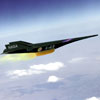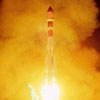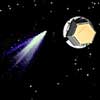|
Sunday:
June 3, 2001 | |
0300 GMT |
 |
NASA's X-43A craft destroyed in launch failure
NASA's bid to test a revolutionary scramjet aircraft on Saturday failed even before it began when the Orbital Sciences-built Pegasus rocket launching the X-43A vehicle veered off course and exploded only moments into flight.
 FULL STORY FULL STORY
 |  |

|
 |
Duo untangle mysteries of Jupiter's magnetic field
In a series of presentations this week at the American Geophysical Union spring meeting in Boston, space scientists have shown how data from the two spacecraft have revealed new features and explained old mysteries about Jupiter's magnetic field.
 FULL STORY FULL STORY
 |  |

|
 |
Space traffic controllers keep satellites safe
A bullet fired on Earth travels 2,700 miles per hour and can do damage for up to 1,000 yards before it stops. A loose bolt in space hits at 17,000 miles per hour, goes through a spacecraft and keeps going. It's one office's job to make sure such a catastrophe doesn't happen.
 FULL STORY FULL STORY
 |  |

|
 |
|
Saturday:
June 2, 2001 | |
0306 GMT |
 |
X-43A craft to make first hypersonic flight today
Imagine an aircraft that can fly at rocket speeds, seven times the speed of sound. Engineers are preparing for the first test flight of NASA's scramjet-propelled aircraft atop a Pegasus rocket on Saturday over the Pacific Ocean.
 FULL STORY FULL STORY
 |  |

|
 |
Satellite maps provide better urban sprawl insight
A major advance in satellite-based land surface mapping has led to the creation of more accurate and detailed maps of our cities. These maps provide urban planners with a better understanding of city growth and how rainfall runoff over paved surfaces impact regional water quality.
 FULL STORY FULL STORY
 |  |

|
 |
|
Friday:
June 1, 2001 | |
1430 GMT |
 |
Station arm computer replacement option nixed
International space station crewmembers won't replace a computer on the outpost's new robotic arm during a planned spacewalk next Friday, officials have decided. The computer had been suspected as the cause of arm trouble, but engineers have since determined the unit is likely not the problem.
 EARLIER STORY EARLIER STORY
 |  |

|
 |
Hubble telescope unveils a galaxy in living color
In this incredible view of the center of the magnificent barred spiral galaxy NGC 1512, the Hubble Space Telescope's broad spectral vision reveals the galaxy at all wavelengths from ultraviolet to infrared. The colors map where newly born star clusters exist in both "dusty" and "clean" regions of the galaxy.
 FULL STORY FULL STORY
 |  |

|
 |
Spectacular photo catches hungry quasar in the act
A new image of a distant quasar -- the luminous core of an "active" galaxy -- shows that it is engaged in a gravitational battle with its neighboring galaxies. It also provides information on how supermassive black holes present in the center of quasars are fed.
 FULL STORY FULL STORY
 |  |

|
 |
Escape route found for Jupiter's particles
Jupiter's magnetosphere, an ionized-gas bubble encasing the planet, is lopsided and leaky, with an unexpected abundance of high-energy particles bleeding out of one side, according to recent measurements by NASA's Cassini spacecraft.
 FULL STORY FULL STORY
 |  |

|
 |
DAILY BRIEFING Other stories making news today
|
 |
Artificial intelligence to command satellite mission -- NASA software that thinks for itself and makes decisions without help from ground controllers will fly as the brains of triplet satellites in 2002. The spacecraft will be launched from the space shuttle in a stack configuration and fly in formation as part of the Three Corner Sat mission.
|
 |
|
Thursday:
May 31, 2001 | |
0424 GMT |
 |
Atlantis delayed to July in wake of station arm trouble
Problems with the international space station's new robotic arm has forced NASA to delay the next space shuttle flight, and the possibility is growing that a daring repair mission to replace one of the crane's joints might be needed before construction of the outpost can continue.
 FULL STORY FULL STORY
 |  |

|
 |
Near-Earth asteroid found to be two chunks in one
The clearest radar pictures of a near-Earth double asteroid system were taken by astronomers last week using NASA's Goldstone radar telescope, revealing clues to the system's current structure but raising questions about its origin and future.
 FULL STORY FULL STORY
 |  |

|
 |
Why doesn't Eros have a magnetic field?
Scientists said this week that they may know the reason why the asteroid Eros appears to lack a measurable magnetic field. Eros was the subject of detailed study for over a year by the Near Earth Asteroid Rendezvous (NEAR) spacecraft.
 FULL STORY FULL STORY
 |  |

|
 |
Quasar's identity may simply be in eye of beholder
Using NASA's Chandra X-ray Observatory, astronomers have made the first
detailed study of a peculiar type of quasar that is shrouded in clouds
of gas and dust flowing outward at millions of miles per hour.
 FULL STORY FULL STORY
 |  |

|
 |
Mars Global Surveyor captures dust storms
Daily global maps, created with images from NASA's Mars Global Surveyor spacecraft, provide a moving picture of Martian weather during 1999-2000 similar to the familiar satellite weather maps we see of Earth.
 FULL STORY FULL STORY
 |  |

|
 |
DAILY BRIEFING Other stories making news today
|
 |
Aerojet studies new nozzle design for shuttle main engine -- Aerojet has won an eight-month, $5 million contract from NASA to study the feasibility of developing a channel wall nozzle to replace the tube nozzle in the Space Shuttle Main Engine.
|
 |
|
Wednesday:
May 30, 2001 | |
0418 GMT |
 |
Shuttle launches might be shuffled to fix station arm
Shuttle Atlantis rolled out of its hangar and into the cavernous Vehicle Assembly Building at Kennedy Space Center on Tuesday, but when the ship will be allowed to launch an airlock to the international space station hinges on work to fix the outpost's new robotic arm.
 FULL STORY FULL STORY
 |  |

|
 |
Boeing's Delta 4 testing rocket arrives in Florida
Fresh off its series of critical test firings, Boeing's Delta 4 pathfinder rocket has arrived at Cape Canaveral to ensure the state-of-the-art launch facilities being built at Complex 37 are ready to handle the maiden flight of the next-generation launcher in March.
 FULL STORY FULL STORY
 STORY ON HOT FIRE TESTS STORY ON HOT FIRE TESTS
 STORY ON DELTA 4 LAUNCH PAD STORY ON DELTA 4 LAUNCH PAD
 |  |

|
 |
Report recommends quarantine of Mars samples
A report released Tuesday urges NASA to begin planning a system to quarantine Martian samples even through missions to return such samples are at least a decade in the future.
 FULL STORY FULL STORY
 |  |

|
 |
Russian Soyuz rocket lofts military satellite
Russia launched an unmanned Soyuz U rocket from Plesetsk Cosmodrome on Tuesday carrying a classified military spacecraft believed to be an imaging spy satellite.
 FULL STORY FULL STORY
 |  |

|
 |
DAILY BRIEFING Other stories making news today
|
 |
All quiet on the Galileo front -- The excitement of the encounter week has settled down now, and activity
levels drop to the quiet murmur which is usual for the cruise portion of an
orbit.
|
 |
|
Tuesday:
May 29, 2001 | |
0154 GMT |
 |
Probe spots newly formed streaks on Martian slopes
NASA's Mars Global Surveyor is currently searching for changes that have occurred in the past martian year on the Red Planet. In a rugged, ridged terrain north of the Olympus Mons volcano one such change is avalanching of dust as seen here.
 FULL STORY FULL STORY
 |  |

|
 |
DAILY BRIEFING Other stories making news today
|
 |
Evidence found for acoustic oscillations in early Universe -- Astrophysicists say they have confirmed the existence of acoustic oscillations generated shortly after the explosive birth of the universe. Their evidence links the existence of acoustic oscillations, or wiggles, in the distribution of both the cosmic microwave background radiation and the distribution of matter throughout the universe.
|
 |
|
Monday:
May 28, 2001 | |
0240 GMT |
 |
NASA approves robotic mission to blast a comet
Imagine intercepting a comet in deep space and using a heavy projectile to blow a hole in the celestial body, some seven stories deep and about the size of a football field. In a space exploration first, NASA's Deep Impact Mission will
attempt to use a probe to collide with a comet in an attempt to peer beneath its surface.
 FULL STORY FULL STORY
 |  |

|
 |
Mars Global Surveyor spots a mid-summer's dust devil
One objective for the Mars Global Surveyor's extended mission is to continue looking for changes and dynamic events taking place on the Red Planet. The feature shown here -- a dust devil -- elicited gasps of excitement among the camera operations staff when it was received.
 FULL STORY FULL STORY
 |  |

|
 |
Solar wind find may help space weather forecasting
Scientists have confirmed the existence of and imaged "free spirit" atoms in the solar wind for the first time. They hope to use the observations to better estimate the arrival time of solar storms and to estimate the amount of dust left over from the solar system's birth.
 FULL STORY FULL STORY
 |  |

|
 |


 The Hubble Space Telescope's majestic view of the Eskimo Nebula. This spectacular poster is available now from the Astronomy Now Store.
The Hubble Space Telescope's majestic view of the Eskimo Nebula. This spectacular poster is available now from the Astronomy Now Store.